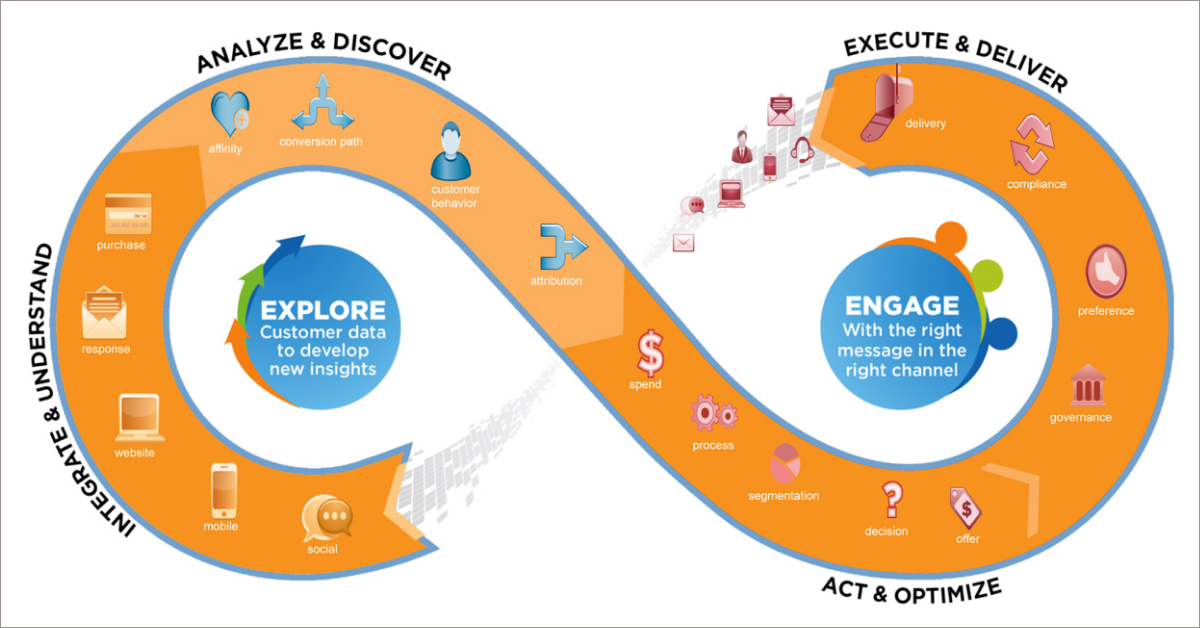Welcome to WebEngage! You’re now one step closer to becoming a Retention champion! Please press play to listen to the audio version of the blog.
Marketing automation is no longer a “good-to-have” but a “must-have” that fast scaling businesses can’t do without in order to meet their target audience and keep them engaged.
Statistics have found that 51% of companies are currently using marketing automation in one way or another. The same survey also found that more than 58% of companies plan to adopt the technology in the coming years.
While the number of companies realizing the importance and need for marketing automation looks promising, those succeeding with it are not too many.
While the number of companies realizing the importance and need for marketing automation looks promising, those succeeding with it are not too many. Read more - via @webengage Share on XThe varying degree of success with marketing automation can be seen owing to their use of data during implementation of processes.
- Why does data play a crucial role in marketing automation?
- How does data boost your marketing automation efforts?
- What is a data-driven marketing automation strategy?
- How to create your marketing automation strategy using data
- Do you really need data in marketing automation?
- Conclusion
Why does data play a crucial role in marketing automation?
Marketing automation is a technology. To be able to leverage it, you still need a marketing strategy. And to create a marketing strategy that is effective, you need data – data on your target market/ audience, your ideal persona, your competitors and more.
So when you tie it all together, effective marketing automation is fueled by data.
Without accurate data on customer behavior and preferences, you’re automating campaigns and processes based on inaccurate or no information at all, which leads to an increased number of leaks in the funnels you set up, bringing down the ROI of your overall marketing automation efforts.
Considering how businesses now have a plethora of channels to gather customer data and learn from their interactions, it’s time that they integrate big data into marketing automation for better results.
How does data boost your marketing automation efforts?
You are aware of the benefits of marketing automation when it comes to boosting productivity and efficiency of teams. But when you combine your marketing automation efforts with data, you are able to see concrete outcomes.
1. Optimized content distribution
Marketers are spending an increasing amount of time in creating, publishing and promoting content to educate their audience, across multiple channels. But with 78% of companies creating content for marketing and sales purposes, it is becoming vital to leverage tools and technologies that enable one to reach the right audience with the right message, on the right channel and at the right time.
With the help of data, you can identify platforms and channels your audience is the most active on, the time they tend to engage with content the most and how they choose to interact with it. This can help you leverage marketing automation to run targeted campaigns across all the channels, leading to better results.
2. Boost in conversions and sales
Studies state that around 48% of data is attributed to customer analytics. Without putting this data to use, your business is relying on a hit or miss marketing and sales strategy.
Considering how 80% of consumers expect brands to personalize their communication with them, the better you can understand them, the more you can tailor your marketing messages and strategy to appeal to their unique preferences and needs.
With marketing automation, you can use this data at scale to create personalized marketing campaigns across all channels. This helps boost the conversions and sales you generate through both organic and paid campaigns across all digital channels.
3. Better personalization at scale
As per Gartner, 27% of marketers believe that lack of data is the main obstacle to running successful personalized marketing campaigns.
Being able to learn about the changing preferences of consumers through interactions is important. In times when the competition for consumer attention is increasing by the day, the importance of delivering an exceptional customer experience cannot be overstated and the only way to keep up is to integrate data into your marketing automation efforts.
For example, if you’re using chatbots to automate customer interactions that involve addressing purchase queries, you should be looking into data closely. Your data will highlight what segment of your audience tends to reach out to you the most, the questions that are repetitive in nature and how effectively you’re able to resolve their queries. The data also gives you clear actionables on what you can do to make their experience better.
4. Consistent and relevant communication
According to a survey conducted by CoSchedule, about 32% of people unsubscribe from a company’s list on receiving content or information that is irrelevant to them.
Considering how important consistent communication is for customer retention in fast-moving industries, businesses can be seen leveraging marketing automation. But to be able to hit relevancy at scale, they also need to bring in data to drive the strategy behind every automated campaign.
When used correctly, marketing automation alongside data, can help you tailor campaigns to individual levels of personalization.
5. Triggered messaging for context-marketing
With the digital landscape growing by the day, there are way too many touchpoints and micro-moments that occur in a buyer’s journey with a brand. Add to that the 5,000 ads an internet user sees on average, and you don’t stand a second chance to connect with your audience.
This means that the one chance you do get to tap into the fragmented and non-linear buyer journey, you need to create campaigns that trigger the right message at the right time, based on a consumer action.
When you dig into data, you are able to identify how different customer segments engage with your brand. You can use the insights to create effective real-time triggers with marketing automation, ensuring you never miss a beat when it comes to engaging high-intent consumers.
For example, when a potential customer subscribes to your email list, you can trigger a campaign to welcome them to your email list and set expectations around what they might receive in emails going forward. You can also further offer them an option to subscribe to specific information only, letting you tailor your email campaigns for high context, using their preference as a trigger.
6. Streamlined campaigns and processes
A marketing automation tool comes with a suite of features that can be leveraged across marketing, sales and support teams. This often results in teams in creating their own internal processes and campaigns to automate tasks as per their current needs.
More often than not, companies end up paying a lofty amount to run their marketing automation efforts due to overlapping or redundant processes across all channels, in different departments.
By bringing in data, you also get to dig deep into your good-to-haves, must-haves, and things that need to be removed. This helps you streamline your processes and your resources, leading to better ROI from campaigns as well as your investment in the marketing automation tool.
7. Enhanced strategic decision making
When you integrate data with your marketing automation strategy, you can learn more about your target audience in real-time. You can also analyze the performance of various aspects of your business – products, services, processes, teams and more.
The comprehensive view of how things work and perform, enables better decision making on all levels.
8. Competitive advantage
Marketing automation makes consumption of data much easier and faster, letting you identify loopholes and opportunities on the go. It brings you closer to understanding your consumers, their changing preferences and their needs, enabling you to optimize your approach even before your competitor does.
Almost 67% of executives say that driving marketing automation with data has enabled them to gain a competitive advantage in their target markets.
9. Ability to predict trends
Marketing automation helps you run campaigns in a more efficient manner. But what it also does is give you collated insights from the performance of all the campaigns, so you can use the insights to predict trends.
When you use data and marketing automation together, you get the ability to also proactively predict market trends and shifts. This lets you adapt your strategy for sustainable growth instead of having to make hurried decisions when consumer behavior changes and your marketing campaigns take a hit.
Simply put, a data-driven marketing automation strategy is the only way you can scale your growth in times when consumer preferences change in a blink of an eye and the competition never ceases to increase.
What is a data-driven marketing automation strategy?
Data-driven marketing refers to the process of mining actionable information from large collections of data across channels. It helps businesses not just understand their target audience better, but also develop new products, services and strategies to offer personalized customer experiences at scale.
Data-driven marketing automation strategy essentially means creating a plan to execute the above at scale.

Subscribe to our newsletter to stay updated on the latest in B2C marketing
How to create your marketing automation strategy using data
Just as you follow a few steps to create a marketing strategy, ensure that you approach marketing automation in a similar fashion.
1. Define your goals
The first step to creating a strategy will always be defining clear goals and objectives. You need to know what you’re trying to accomplish by implementing a data-driven marketing automation strategy in your company.
Your goals can vary based on the problem you’re trying to solve or the scale at which your business runs. Some of the common objectives of a data-driven marketing automation strategy include being able to personalize buyer journeys, improve customer satisfaction, reduce customer churn, improve high-quality lead generation, offer superior customer experience and boost customer engagement.
2. Get your team in place
Implementing marketing automation should not be a siloed process for a specific team. Since the processes and data will be used across all departments including marketing, sales, support and success, it is important that you get all the stakeholders involved.
Clearly define who you need insights from in every department, and their role in defining the scope of marketing automation.
3. Identify the right sources of data
There is no dearth of data today owing to the ever-expanding digital landscape. But not all data is the information your business needs for creating a marketing automation strategy. To make the right decisions, you need access to the right sources of data.
To be able to do this, you need to clearly identify the data you need for each goal or objective you plan on tackling with marketing automation. Then, you need to identify your source of truth for those data points across different departments, and explore integrations that will help you bring that data onto the marketing automation platform.
At this stage, you should also keep in mind that while you’re ensuring the right in-flow of data, there should also be a seamless flow of data ‘from’ your marketing automation platform to enable growth across all departments.
Some of the critical data you need easy access to includes:
- Behavioural Data – Web and social interactions of customers and prospects, their likes and preferences, and their dislikes.
- Historical data – Data points such as purchase history, support queries, known and unknown requests.
- 360-degree view of customers – Customer interactions across all the digital touchpoints and their stage in the life cycle.
To ensure the data quality of the above, it is also important for the team creating a strategy and implementing marketing automation, to adhere to some compliances:
- Consistently assess the quality of existing data and its degree of reliability
- Create data profiling rules
- Convert these rules into processes to ensure a standardized data format
- Document the processes as a part of your marketing automation strategy
- Embed the processes into your automation system to automate validation and correction of data
- Audit the data for quality checks at defined intervals
4. Integrate your tools and technologies
A marketing automation platform should not be running as an independent unit. It should be a part of your existing technology stack in a meaningful way.
This essentially means that when you define your sources of data, you need to ensure that the flow of data to the platform is seamless and error-free. That’s where integrating your tools and technologies comes into play.
A good marketing automation platform will enable you to easily integrate with various other service providers and solutions you’re currently using. This includes the marketing tools you’re making use of for emails, SMS, web push and other purposes, your customer support tools, your sales enablement platforms and your CRM.
5. Leverage automation to enhance customer experience
Once you have your goals clearly defined and a plan of action on how you will enable marketing automation with data, it’s time to get into identifying repetitive tasks and processes that need to be executed at scale.
These are things you need to automate across all the channels you have established as digital touchpoints with your consumers. This could include interactions made on your website, through web push notifications, email, SMS or other channels.
Also keep in mind how you’d like to enable easy hand-offs if and when an automated campaign across any of the channels requires you to step in manually for one-to-one personalization of conversations.
6. Measure and optimize
An effective marketing automation strategy is one that continually focuses on optimizing the approach with the help of data.
Most companies use marketing automation with a ‘set it and forget it’ mentality, which leads to campaign exhaustion and redundancy over a period of time, lowering the impact of even the most thought through campaigns.
Most companies use marketing automation with a ‘set it and forget it’ mentality, which leads to campaign exhaustion and redundancy. Read more - via @webengage Share on XThis is where it becomes important to ensure that you’re keeping a close eye on the performance of your marketing automation efforts. Use the insights to identify opportunities to deliver a better experience and optimize on the go.
7. Spring clean often
Just as your email list requires frequent cleaning to keep it healthy, so does your marketing automation strategy and platform.
Make sure that when you’re measuring the impact of your campaigns, you’re also taking note of how the performance is scaling across various channels and platforms. This will help you identify places you are draining resources without much ROI and those you need to double down on instead to reach your target goals faster.
It’s okay to spring clean your marketing automation processes, removing the junk out – based on data, and not assumptions.
Do you really need data in marketing automation?
Marketing automation is meant to make your marketing and sales efforts more efficient. While most companies are leveraging its capabilities for ‘efficiency’, not too many are tapping into what the technology has to offer for also ensuring ‘effectiveness’ of campaigns.
A good marketing automation tool brings data from multiple sources and campaigns on different channels, onto one dashboard. It collates data to help you get an overview of your overall marketing efforts and the impact of your campaigns on a granular level.
Not using this data to optimize your strategies is like leaving money on the table and turning your back to opportunities that your competitors won’t think twice about tapping into.
Conclusion
Yes, you need data to fuel your marketing automation so that you can push the junk (ineffective campaigns and processes) out to focus on what really matters and brings growth to your company.
Looking for a good Marketing Automation Tool? WebEngage is Better! Take a demo with WebEngage


































 Vanhishikha Bhargava
Vanhishikha Bhargava
 Kasturi Patra
Kasturi Patra
 Sharath Byloli
Sharath Byloli



